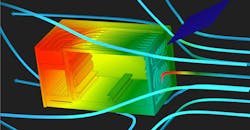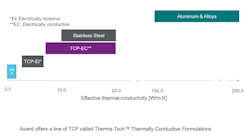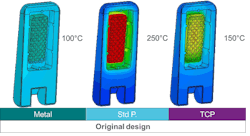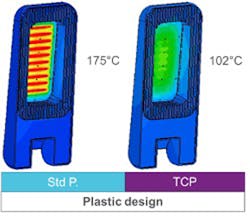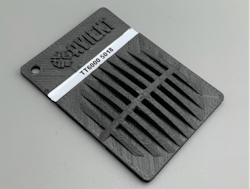Shedding Heat on Thermal Plastics for Lighting
According to recent market studies, thermally conductive plastics (TCPs) will significantly influence lighting applications during the coming years. In a recent study published on UL Prospector, the global market for TCPs in automotive LED applications is forecasted to reach $255.6 million by 2025. Another market where the stakes are high is street lighting. Within 10 years in Europe, 40% of city energy costs are forecasted to be consumed by streetlights. More than €8 billion is expected to be invested with plans for 90% of streetlights to be equipped with LEDs by 2029.
Developing novel lighting systems is imperative to keeping pace with the growing need for more efficient and connected lighting. For such applications, a TCP is a viable and efficient solution when the trifecta of design, material and process is controlled. Avient confirmed this by evaluating the possibilities and limitations of TCP as compared to aluminum heatsinks with the aid of digital and physical prototyping to speed product development, avoid pitfalls and reduce costs.
What are TCPs?
TCPs are formulated to increase the thermal conductivity of standard plastics by 10-20× their base property, as illustrated in Fig. 1. While TCPs are significantly less conductive than aluminum, a well-adapted design will do the job and offer many advantages of design flexibility, lightweighting, lower system cost and few process steps. Thermal management can be critical for lamps equipped with LEDs, which are at risk of malfunctioning when overheated.
Because the material properties of TCPs and aluminum differ greatly, a simple 1-to-1 metal-to-plastic conversion will not suffice. In the case of a recent street lamp project, Avient Design, the company’s design and engineering group, was tasked with replacing the aluminum heatsink with one made using a Therma-Tech TCP formulation from Avient. At the same time, many application specifications needed to be met, including a reduction in cost, UV resistance/weatherability and added flexibility in the design to integrate specific functions such as a 5G antenna.
The goal was to improve thermal management of the system to never exceed the critical maximum temperature of 110°C to ensure a long lifetime of electrical components.
Digital tools were utilized to evaluate the thermal performance of different heatsink materials and geometries. The performance was tested within the given assembly pictured in Fig. 2, using computational fluid dynamics (CFD) to simulate the heat dissipation from an LED heat source. CFD was selected to capture the convection phenomenon by simulating the fluid surrounding the lamp. The choice and need for CFD to correctly predict this fluid behavior limits the number of assumptions needed in the simulation and enables greater precision.
The digital prototypes show the limitations of TCPs without optimizing the design, as shown in Fig. 3. When the aluminum was replaced in the original design, temperatures in the standard plastic could reach 250°C. The TCP was shown to improve the result to 150°C but far exceeded the limit.
Many concepts were developed and presented to the customer to increase the heatsink surface area for convection heat transfer and to allow for the best processability.
The new design was digitally prototyped to compare to the original design and results. The new design significantly lowered the standard plastic temperature to 175°C. What stood out the most for the new design was the TCP meeting the maximum temperature criteria, as seen in Fig. 4.
The new design was molded, tested and ultimately validated the simulation results with a 4°C temperature difference between the simulation and the real test, proving the numerical model was very predictive. The results can be seen in Fig. 5. This does not only mean that the digital solution is performing well, it also means that there is now an accurate digital twin of the test in hand, and any future changes to the digital model will be reflected in the physical prototype. With the ability to quickly iterate and understand the impact of those changes, producing many rounds of physical prototypes can be avoided, facilitating innovation and accelerating development times.
The gap between digital prototypes and production tools can be reduced even further. Avient Design has developed 3D prototyping technologies that enable semi-functional prototypes to be made in the final material. This is done at a significantly lower cost and time than traditional metal prototyping tools and provides a similar performance to validate the design and its expected performance within the overall assembly.
In a recent project with an automotive lighting partner, an injection molded TCP heat sink was tested against a 3D printed TCP prototype. The prototype was confirmed to be semi-functional with 86% functionality compared to the molded part. These results were enough to enable early decision-making of the design and material and avoid rounds of metal prototyping tools.
The combination of material advancement, digital simulation and physical prototyping has helped to remove the barrier to change and uncover the opportunities of thermal transfer via plastic design.
Brian Everett is global director of Avient Design at Avient Corporation.
